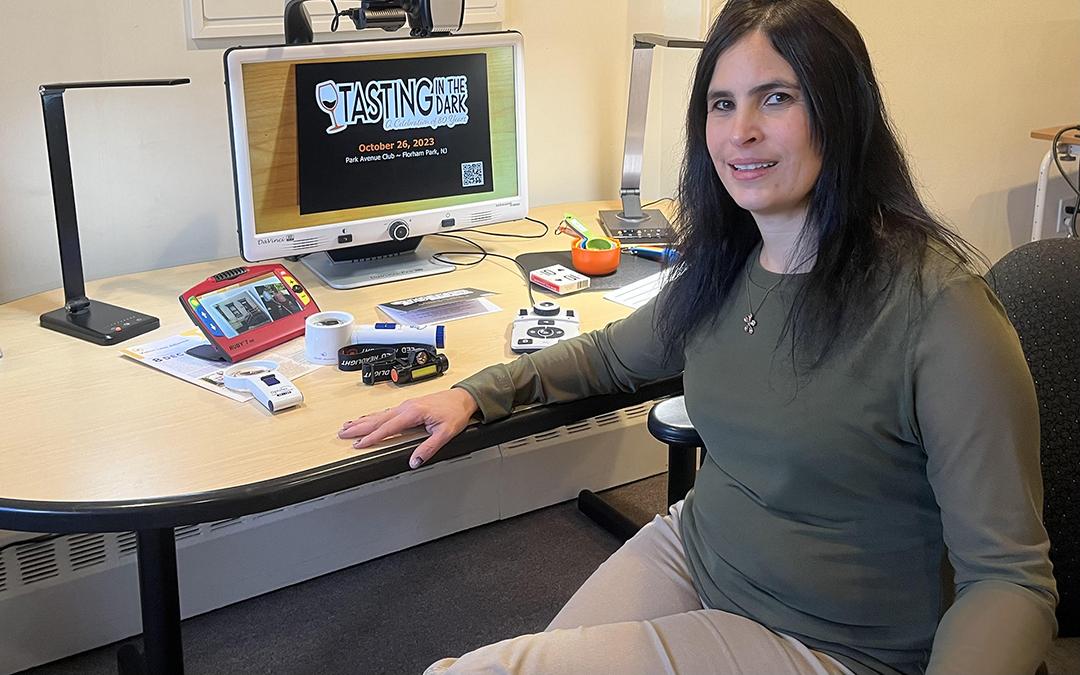
by admin | Oct 27, 2023 | Events, Feature, Press Releases, Program
This program brings the convenience of Low Vision Occupational Therapy services to a person’s home. This program focuses on addressing safety and independence in completing daily living activities and the Occupational Therapist can provide timely, specific individualized recommendations in strategies to adjust lighting, enhance contrast, improve household organization, and reduce the risk of falls and self-injury in the home.
Click here for more information.
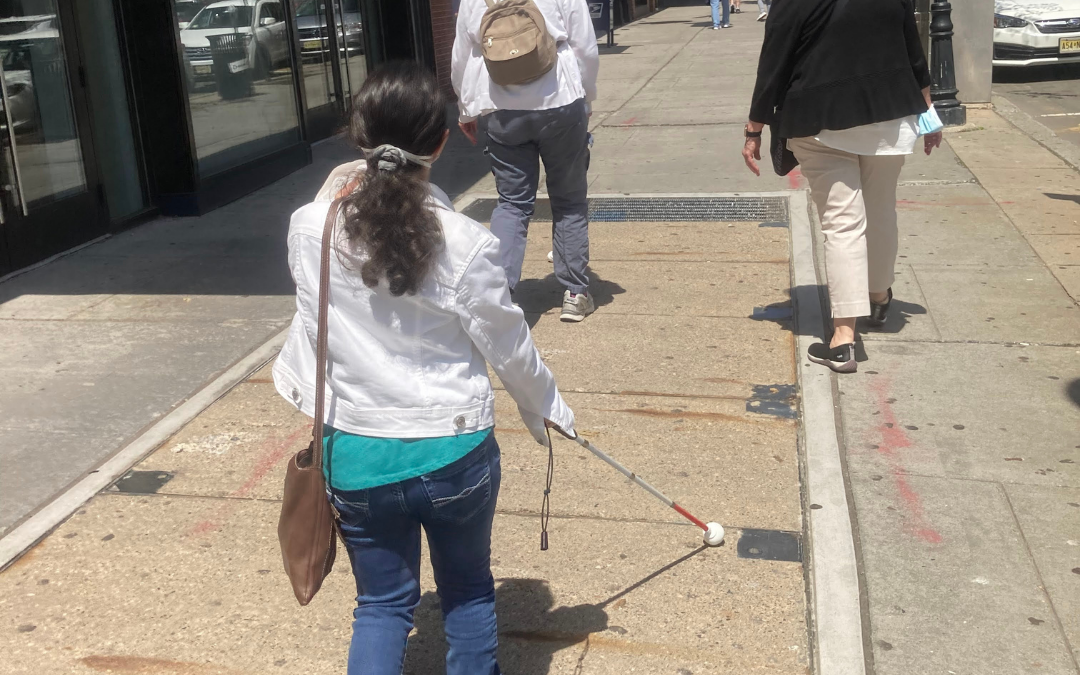
by Carly Eden Stokes | May 27, 2022 | Blog, News, Press Releases
MORRISTOWN, NJ (May 26, 2022) — Guide dogs are part of Morristown’s fabric, but on Monday, participants from Vision Loss Alliance of New Jersey used white canes to traverse the town’s sidewalks and intersections.
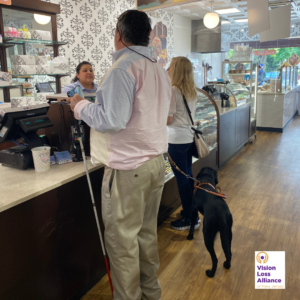
An individual holds a white cane while another has a guide dog at the checkout counter of a Morristown, NJ business.
Three orientation and mobility specialists from The Seeing Eye and VLANJ’s O&M expert provided one-on-one instruction to participants on a route that included several blocks of Maple Avenue and South Street. While one group of participants received instruction, the other toured a local business, and after lunch, they swapped roles.
“It’s so important for people with vision loss and blindness to learn mobility skills and practice how to safely navigate indoor and outdoor public spaces, as well as sidewalks, and crosswalks,” VLANJ Vice President of Programs Elsa Zavoda said. “It provides them greater self-confidence to venture out in their own communities and beyond.”
The O&M outing was the third in a series, generously funded by grants from the William G. and Helen C. Hoffman Foundation and the Lydia Collins deForest Charitable Trust. The O&M specialists from The Seeing Eye, including VLANJ trustee Lukas Franck, volunteered their services.
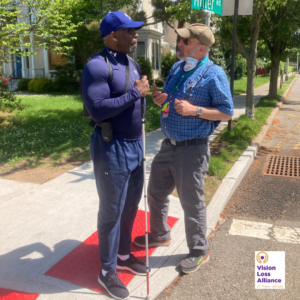
Two individuals stand at a street corner in Morristown. One holds a white cane.
Peggy Kane went out with The Seeing Eye’s Kristin Lake, who first fitted her with a global positioning system that alerted Kane to upcoming intersections. As they walked along Maple Avenue, Lake noted uneven sidewalks in places, and reviewed cane techniques. Kane knew the importance of listening to traffic flow to know when it’s safe to cross an intersection that doesn’t have a walking signal.
“I don’t travel out in the community by myself as much anymore, so it was good to have the opportunity to practice my outdoor navigation skills,” Kane said.
Franck, a senior consultant at The Seeing Eye, worked with Marvin Morgan. At the traffic light at Maple Avenue and Miller Road, Franck coached Morgan to raise his pole to signal his intention to cross before stepping into the crosswalk.
Inside Braunschweiger Jewelers on South Street, owner Gretchen Braunschweiger stood at a circular display case and took out highly textured estate pieces for the VLANJ participants to handle.
Feeling a thick gold chain, Matthew Graves said, “This feels like a glow stick.” He tapped on a thick, smooth sterling silver bangle and said,“it feels and sounds like glass!”
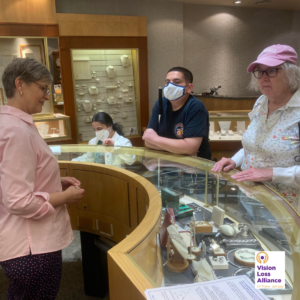
Two individuals stand at the counter of Braunschweiger Jewelers in Morristown. A woman greets them behind the counter.
After examining more than a dozen pieces of jewelry, the VLANJ participants showed Braunschweiger mobility techniques they learned. Mary Ann Zino demonstrated trailing, using her cupped hand to feel her way around the circular jewelry display. Nicole Klein showed her different cane techniques to move around the store.
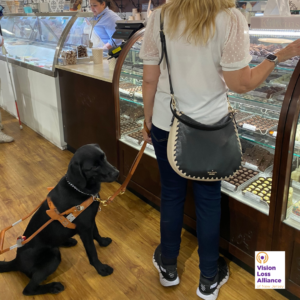
A woman holds her guide dog in front of a counter filled with sweets at a local Morristown business.
Braunschweiger said people with vision loss often visit the store, but usually, they are with guide dogs. When they enter, “someone goes up to the front to greet them,” she said.
After lunch, the participants who did orientation and mobility training in the morning visited Blue Mercury, a makeup and skin care shop on the Morristown Green. The VLANJ participants learned about products and smelled perfumes and colognes, and demonstrated human guide technique to Blue Mercury staff. The outing ended with a visit to Kilwins Morristown for ice cream.
About Vision Loss Alliance of New Jersey
Vision Loss Alliance of New Jersey is a 501(c)(3) that provides practical training and emotional support to help those who have experienced profound vision loss regain self-esteem and self-reliance. Since its founding in 1943, Vision Loss Alliance of New Jersey has used a holistic approach to empower those with profound vision loss to live engaged, productive and independent lives. Explore vlanj.org for more information.
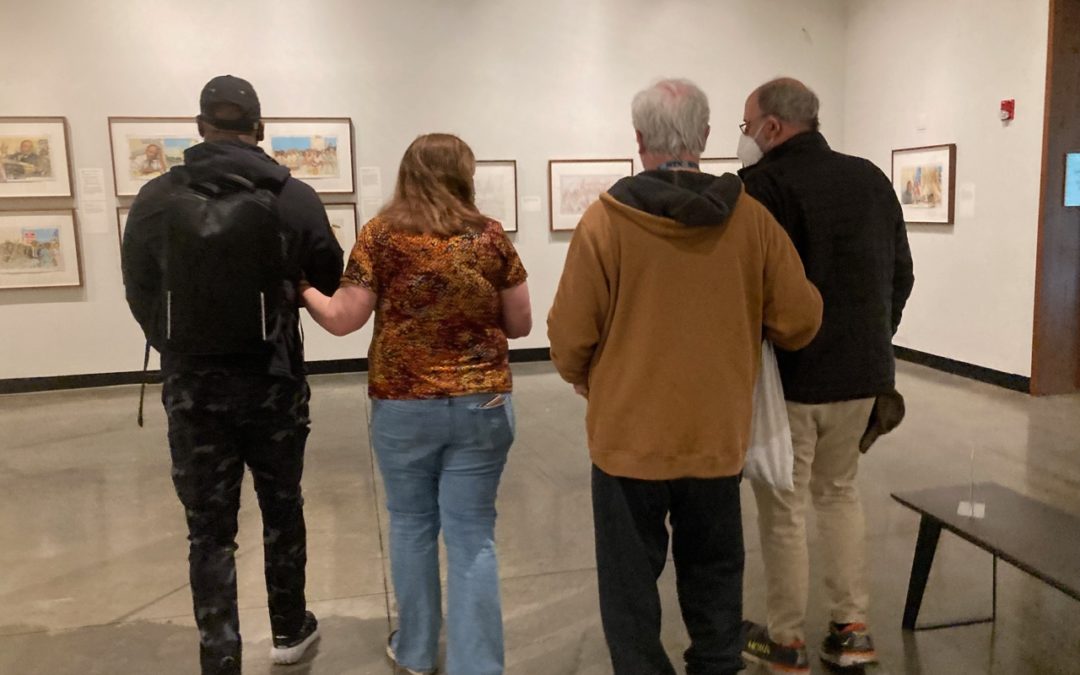
by Carly Eden Stokes | Mar 30, 2022 | Blog, Events, News, Press Releases
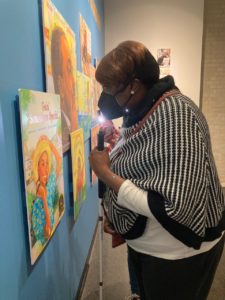
Valerie Frink of Jersey City, a VLANJ participant, closely inspects a bright, colorful work by artist Jerry Pinkney, using the flashlight on her mobile phone.
MONTCLAIR, NJ (March 30, 2022) — As part of its effort to expand access for people with special needs, the Montclair Art Museum last week gave Vision Loss Alliance of New Jersey participants a guided exhibit tour that featured detailed audio descriptions of artwork and multi-sensory objects to help visualize pieces.
“I liked being able to feel the object related to the artwork, and hear about the artist and materials used,” said VLANJ participant Debbie Tester, who has lost most of her sight to a degenerative eye disease. “It helped me get a picture in my head.”
The MAM tour was VLANJ’s second orientation and mobility community outing to learn and practice getting around in public spaces. The outings are generously funded by grants from the William G. and Helen C. Hoffman Foundation and the Lydia Collins deForest Charitable Trust. Two VLANJ orientation and mobility experts accompanied the group and provided training inside the museum and on its grounds.
VLANJ participants gave MAM’s program high marks. “Make it longer!” suggested Roman Dodia. Montclair State University Associate Professor Maria José Garcia Vizcaíno, who volunteers as a docent, narrated the exhibit, “Transformed: Objects Reimagined by American Artists.”
![VLANJ participants view a black panther sculpture during a Montclair Art Museum tour on March 25. [MAM photo credit]](https://www.vlanj.org/wp-content/uploads/2022/03/IMG_4727-225x300.jpeg)
VLANJ participants view a black panther sculpture during a Montclair Art Museum tour on March 25. [MAM photo credit]
MAM is committed to expanding access for people with special needs. It recently created the position of assistant director of Community and Access Programs, held by Celene Ryan. The museum offers virtual programs and runs in-person art classes that provide more support, with one-on-one or small-group instruction, Ryan said. New Jersey residents who receive Division of Developmental Disabilities funding can use the money to take MAM classes, she noted.
The VLANJ participants asked astute questions as they moved through the gallery, Ryan said. “They were really engaged.” They then provided feedback on the tour and MAM’s accessibility efforts in a focus group run by Montclair State University Associate Professor Elaine Gerber.
The nine VLANJ participants offered a range of useful suggestions, such as having the museum’s floor plan mapped on a GPS system like GoodMaps to help visually impaired people get around. They suggested information about artwork on plaques have a companion audio description, and that tape on the floor marking how close visitors can get to artwork be textured so people using canes can identify it.
VLANJ Vice President of Programs Elsa Zavoda demonstrated mobile phone apps that allow people with vision impairment to listen to written information about artwork. Because of the museum’s high ceilings, Zavoda recommended MAM tour guides use lapel amplifiers so visitors don’t miss narrations.
Museum Director Ira Wagner noted MAM tries to incorporate social elements into programming, inviting artists to speak. To thank VLANJ participants for their input on improving access, Wagner offered the group one-year memberships to MAM.
For more information about MAM, visit montclairartmusuem.org.
Visit vlanj.org to learn about VLANJ programs.
————-
About Vision Loss Alliance of New Jersey
Vision Loss Alliance of New Jersey is a 501(c)(3) that provides practical training and emotional support to help those who have experienced profound vision loss regain self-esteem and self-reliance. Since its founding in 1943, Vision Loss Alliance of New Jersey has used a holistic approach to empower those with profound vision loss to live engaged, productive and independent lives. Go to vlanj.org for more information.
About the Montclair Art Museum
The Montclair Art Museum (MAM) boasts a renowned collection of American and Native American art that uniquely highlights art-making in the United States over the last 300 years. The Vance Wall Art Education Center encompasses the Museum’s educational efforts, including award-winning Yard School of Art studio classes, lectures and talks, family events, tours, and the mobile MAM Art Truck. MAM exhibitions and programs serve a wide public of all ages and abilities, from families and seniors to artists, educators, and scholars.
by Carly Eden Stokes | May 4, 2021 | Blog, News, Press, Press Releases
Vision Loss Alliance of New Jersey welcomes William Schuldt, a seasoned nonprofit professional, as its new president and CEO!

William Schuldt, VLANJ’s New President and CEO, is smiling.
“Bill has solid management experience, and a passion for serving people with disabilities,” VLANJ Board of Trustees President Carl Augusto said. Schuldt’s selection by the VLANJ’s board of trustees culminated a nationwide search, Augusto noted. “We feel he’s a perfect fit to guide us toward growth and new heights of accomplishment.”
“I’m very excited to join VLANJ,” Schuldt said. “I’m very passionate about helping people with disabilities live their best life, and maximizing their independence.” Schuldt replaces Kris Marino, who led VLANJ for 6 ½ years.
Schuldt worked 33 years at Spectrum for Living, an organization serving more than 800 adults with developmental disabilities in New Jersey. He began his career working directly with clients, but moved into management positions over the years. He most recently served as vice president for operations.
“The connection with our clients is the most exciting thing to me. They feel like family,” the New Jersey native said. Schuldt said he was moved watching a recording of VLANJ’s 2020 virtual Dining in the Dark fundraiser and hearing participants’ stories about the impactful role the nonprofit has played in their lives.
Schuldt plans to work with VLANJ staff to expand quality virtual programming, while also preparing to reopen in-person classes. VLANJ quickly pivoted to online classes when the COVID-19 pandemic began. Enrollment increased three-fold, as people from across the state and beyond logged in or called in to a growing list of virtual programs.
“It’s time to take it to the next level,” said Schuldt, the father of three daughters. Schuldt’s other priorities for VLANJ include forming alliances and connections with other providers, and continuing to expand its exposure throughout the region and state. Schuldt and his wife, Sherrine, live in Hawthorne.
VLANJ, one of the state’s longest-serving nonprofits for adults who are blind or visually impaired, intends to expand services to meet the growing need, Augusto said. More than 160,000 New Jersey residents are blind or have severe vision loss, and that number is expected to increase as the population ages. By 2034, adults age 60 and over are projected to make up 25.4% of the state population.









![VLANJ participants view a black panther sculpture during a Montclair Art Museum tour on March 25. [MAM photo credit]](https://www.vlanj.org/wp-content/uploads/2022/03/IMG_4727-225x300.jpeg)
